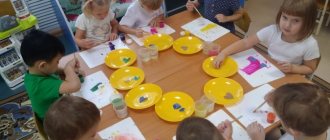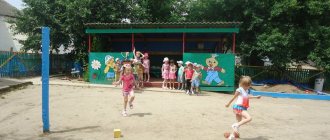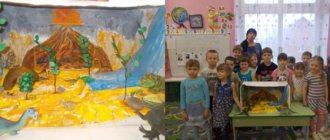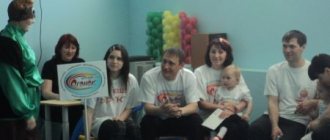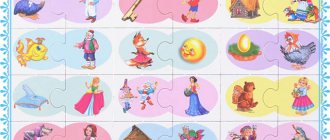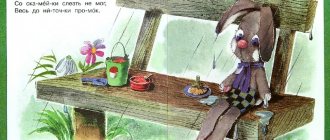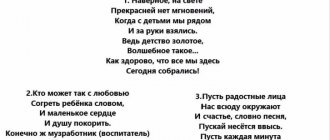Development of a joint project of the teacher, children and parents
Family and kindergarten are the two most important institutions for the socialization of preschool children. In light of the implementation of the Federal State Educational Standard for Preschool Education, the relationship between kindergarten and family is defined by the concepts of “cooperation”, “interaction”, “partnership” .
Project activities, due to their specificity, are focused on creating conditions that reveal the creative and intellectual potential of preschool children, and are aimed at dialogical interaction between children, parents and teachers. Working on projects promotes self-knowledge and self-development of all participants in the pedagogical process.
Photo – Mezen Pedagogical College
Module B. “Interaction with parents (legal representatives) and employees of an educational organization” Task 1. Development of a joint project of the teacher, children and parents, preparation of a presentation about the stages of the project and its results using ICT for speaking about the project at a parent meeting.
Based on the characteristics of project activities in preschool educational institutions, participants were offered a task aimed at the following result:
1. A completed project passport for all subjects of the educational process of the preschool educational institution in accordance with the given topic (on paper).
- Presentation of the stages and results of project activities for all subjects of the educational process of preschool educational institutions using ICT, designed in accordance with a given topic, taking into account the presentation for an audience of parents of preschool children.
- Demonstration of the presentation to an audience of parents (volunteers with an acting task, voicing pre-formulated questions (30%) about the presentation for the participant during the presentation).
Photo – Mezen Pedagogical College
All competitors professionally and creatively approached the task, which required careful and fairly lengthy preparation (2 hours) and a brief presentation of the results of the work done as part of a fragment of the parent meeting.
It was amazing to see how the teachers managed to comprehensively, succinctly and vividly present all the stages and aspects of the jointly implemented project in the allotted 5 minutes.
The presentations of the competitors clearly demonstrate that they are fully proficient in the skills of implementing project activities in a preschool educational institution, understand its essence and significance, know how to methodically correctly organize work at the relevant stages of the project, distribute roles and responsibilities between participants.
Photo – Mezen Pedagogical College
The holiday of February 23 was chosen as the theme for joint activities, which was due to the time of year and the desire to increase the sense of patriotism in children. Therefore, this project had not only a practical result, but also important educational significance. Type of project: cognitive-creative, short-term in time (2 weeks), conducted in the senior group. Project products: matinee, exhibition of children's postcards, sports festival, wall newspaper, photo album “We Serve the Motherland.”
The competitors demonstrated project presentation skills, the ability to systematize and present information in various forms, including quantitative and statistical data in the form of diagrams.
Photo – Mezen Pedagogical College
It should be noted the warm, trusting relationship between teachers and parents, imbued with a mutual sense of gratitude. The teachers presented parents with letters of gratitude and tickets to the Local History Museum.
Volunteers plausibly and organically acted as parents and asked relevant questions: “What difficulties arose during the implementation of the project? What are the prospects for our future work? Will there be more joint projects? Have children begun to show interest in historical places?” The teachers' responses were only positive!
In general, we can say that an ideal model of interaction between the three sides of the educational process in kindergarten was presented during the implementation of joint project activities. And this is exactly the model our graduates will bring to life!
Mezen Pedagogical College
The importance of joint activities between a child and an adult
Modern social life has led to the need to introduce new teaching standards and requirements for education, to create innovative pedagogical technologies that will contribute to the individual development of the child’s personality, the formation of his independence and creative activity. All this requires not only the conscious and active participation of children, but also the involvement of their parents in various activities.
Are you an expert in this subject area? We invite you to become the author of the Directory Working Conditions
Currently, in pedagogical practice there is a demand for including various types of joint activities of children and adults in the pedagogical process. This is due to the fact that joint activities contribute to the activation of search and creative activity in children of different ages.
Definition 2
Designed joint activity is one of the types of pedagogical technology that involves independent or collective creative work of children and adults.
At the heart of any joint activity project is a problem, the solution of which requires its participants to independently search for the necessary information, master new things, generalize and analyze the results obtained. As a result of this activity, participants receive a specific product.
Note 1
The relevance and popularity of the designed joint activity lies in the fact that it combines various areas of education.
Finished works on a similar topic
Course work Designing joint activities of adults and children based on pedagogical technologies 460 ₽ Abstract Designing joint activities of adults and children based on pedagogical technologies 270 ₽ Test work Designing joint activities of adults and children based on pedagogical technologies 190 ₽
Receive completed work or specialist advice on your educational project Find out the cost
Recently, joint activities are increasingly used in educational institutions, and therefore teachers are constantly looking for ways to improve and update them.
The topics of organized joint activities between children and adults are very diverse. Moreover, it can be organized both in the process of educational activities and during events outside educational activities. Often parents take part in precisely such events. Teachers involve parents in joint activities within the framework of parent-child projects.
The significance of joint activities between adults and children lies in the fact that modern children have a reduced interest in “live” communication. This is due to information progress, which has crowded out real-life communication from children’s lives. Children of preschool and school age prefer virtual communication to communication with adults and peers. This negatively affects the overall development of children, and especially their speech development.
In addition, the significance of the joint activity of parents and children lies in the fact that modern parents pay extremely little attention to their children, shifting the entire burden of upbringing and education to the educational institution. This is why it is so important to design joint child-adult projects within educational organizations, involving the family in joint creative activities.
Tasks of younger preschool age
Thus, in primary preschool age the tasks are as follows:
- stimulate interest in the proposed activities;
- involve children in the learning process;
- for the formation of various concepts;
- Involve children in reproducing pictures using a variety of options;
- Encourage children to jointly explore and experiment.
Improvement of mental processes:
- Formation of emotional interest;
- Familiarization with objects and actions with them;
- development of thinking and imagination;
- Language development.
Formation of skills and abilities of project research:
- awareness of the goal;
- Possession of various methods of solving assigned problems;
- Ability to predict results based on past experience;
- Look for different means to achieve your goal.
Lines of personality development in early preschool age according to directions.
1) Physical development:
- Stimulating the natural process of development of motor skills and qualities;
- Formation of conscious ideas about the need to take care of one’s own health (for example, the role-playing project “The ABC of Health”);
- Social development: formation of communication methods (for example, opening “My Family”, individual family projects “Family Tree”).
2) Cognitive development:
- Enrichment and expansion of ideas about the world around us;
- expansion and qualitative change in the possibilities of orientation in the surrounding world;
- conscious use of the senses when solving practical problems (for example, mathematical collages, intergroup project “The World of Animals and Birds”, creative projects “My Friends”, “The World of Nature”).
3) Aesthetic development:
- Development of an emotional-evaluative attitude towards works of art and artistic images;
- Mastery of artistic activities (for example, complex projects “World of Theater”, role-playing projects “Favorite Toys”, etc.).
The second stage is developmental, it is typical for children 5-6 years old, who already have experience in various joint activities, can coordinate actions, and help each other. The child makes requests to adults less often and organizes joint activities with peers more actively.
Children develop self-control and self-esteem; They are able to fairly objectively evaluate their own actions and the actions of their peers. At this age, children accept the problem, clarify the goal and are able to choose the means necessary to achieve the result of the activity. They not only show a willingness to participate in projects proposed by adults, but also find problems on their own.
The third stage is creative, it is typical for children aged 6-7 years. At this stage, it is very important that adults develop and support children’s creative activity, create conditions so that children can independently determine the purpose and content of the upcoming activity, choose a way to work on a project and be able to organize it.
Features of the implementation of the design method in preschool educational institutions
The project method can be represented as a way of organizing the educational process, based on the interaction between teacher and student, a way of interacting with the environment, and step-by-step practical activities to achieve a set goal.
The transfer of a preschool institution to a project-based method of activity is usually carried out in the following stages:
- Classes including problematic situations of children's experimentation, etc.;
- integrated topic block classes;
- integration: partial or complete;
- project method as a form of organizing educational space; as a method for developing creative cognitive thinking.
Work in this direction is implemented primarily through the training of teachers, educational work with parents, and the creation of a subject-spatial environment in accordance with the requirements of the design method.
The implementation of the above technology imposes certain requirements on the teacher as a creative person and special training to improve pedagogical professionalism, since a teacher who masters the project method as a technology and as an activity for co-creating a professional space can teach a child to design.
The teacher acts as an organizer of children's productive activities, as a source of information, as a consultant, as an expert. He is the main leader of the project and subsequent research, gaming, artistic, practical activities, the coordinator of individual and group efforts of children in solving the problem. Therefore, the introduction of the project method into practice begins with organizing work with the teaching staff. These can be the following methods and forms of work: seminars, consultations, joint viewing of lessons, simulation games, methodological exhibitions, master classes, conversations, debates, workshops, trainings, round tables, work with teaching materials, days of mutual visits, project presentations. Exemplary projects on working with human resources are presented in Appendix 2.
The main goal of introducing the project method in a preschool institution is the development of the child’s free creative personality, which is determined by the developmental goals and objectives of children’s research activities.
The goal is to determine learning goals, create learning conditions and research skills in accordance with the main lines of development. The project method gives the child the opportunity to:
- experiment, synthesize acquired knowledge;
- develop their creativity and communication skills, which allows them to successfully adapt to the changing learning situation at school.
The project method can be used in working with children not only of older, but also of younger preschool age. The objectives of research activities are specific for each age and make it possible to determine learning goals and create conditions for the formation of educational and research skills in accordance with the main lines of development.
To implement the project, the teacher determines the stages of implementation, thinks through the content of the activity and selects practical material. In this case, when planning project activities, the teacher must remember the three stages of development of project activities in preschoolers, which are one of the pedagogical technologies of project activities, including a set of research, search, problem-oriented, creative methods.
The first stage is imitation and performance, the implementation of which is possible in children aged 3.5-5 years. At this stage, children participate in the project “in a secondary role”, perform actions at the direct suggestion of an adult or through his imitation, which does not contradict the nature of a small child; at this age there is still a need to form and maintain a positive attitude towards an adult and imitate him.
